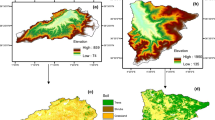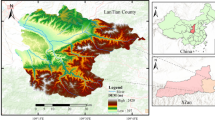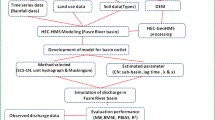Abstract
Flood simulation in sub-humid regions is one of the difficult issues in hydrology. Liulin experimental watershed, a typical sub-humid region in northern China, was selected for flood simulation. 20 rainfall–runoff events from 1995 to 2021 were selected to calibrate and validate the sub-distributed HEC-HMS model. The applicability of the model to flood simulation in the Liulin experimental watershed was explored. The influences of different runoff generation methods (SCS-CN method and initial constant method) and simulation time steps (1 h and 30 min) on flood simulation were compared. The applicability of the model to different antecedent moisture conditions and different flood characteristics was also analyzed. The results showed that all the schemes of rainfall–runoff models with different runoff generation methods and time steps have satisfactory performance in simulating floods. When the time step is 1 h, the initial constant runoff generation method was more suitable for runoff simulation, however, when the time step is 30 min, the SCS-CN runoff generation method was more robust. As the simulation time step decreased, the model performance was improved, but the improvement amplitude was greater when the SCS-CN method was used. In addition, the model performed better when antecedent moisture was higher, and the flood was single-peak. When the measured peak discharge was lower than 100 m3/s, the model could simulate the peak discharge and peak time better, and conversely, the model could simulate the flood volume and flood hydrograph better. This study is valuable for flood forecasting in sub-humid areas.











Similar content being viewed by others
References
Abbott MB, Bathurst JC, Cunge JA et al (1986) An introduction to the european hydrological system—systeme hydrologique europeen, “SHE”, 1: history and philosophy of a physically-based, distributed modelling system. J Hydrol 87(1–2):45–59. https://doi.org/10.1016/0022-1694(86)90114-9
Ali M, Khan SJ, Aslam I, Khan Z (2011) Simulation of the impacts of land-use change on surface runoff of Lai Nullah Basin in Islamabad, Pakistan. Landsc Urban Plan 102(4):271–279. https://doi.org/10.1016/j.landurbplan.2011.05.006
Avila-Aceves E, Plata-Rocha W, Monjandin-Armenta SA et al (2023) Geospatial modelling of floods: a literature review. Stoch Environ Res Risk Assess 37(11):4109–4128. https://doi.org/10.1007/s00477-023-02505-1
Beven KJ, Krikby MJ (1979) A physically based variable contributing model of basin hydrology. Hydrol Sci Bull 24(1):43–69
Brighenti TM, Bonumá NB, Srinivasan R et al (2019) Simulating sub-daily hydrological process with SWAT: a review. Hydrol Sci J 64(12):1415–1423. https://doi.org/10.1080/02626667.2019.1642477
Burnash RJ, Ferral RL, McGuire RA (1973) A generalized streamflow simulation system: conceptual modelling for digital computers. U.S. Department of Commerce, National Weather Service, Silver Springs, MD and State of California, Department of Water Resources, Sacramento, CA
Buttinger-Kreuzhuber A, Konev A, Horváth Z et al (2022) An integrated GPU-accelerated modeling framework for high-resolution simulations of rural and urban flash floods. Environ Model Softw 156:105480. https://doi.org/10.1016/j.envsoft.2022.105480
Castillo VM, Gómez-Pñaza A, Martinez-Mena M (2003) The role of antecedent soil water content in the runoff response of semiarid catchments: a simulation approach. J Hydrol 284:114–130. https://doi.org/10.1016/S0022-1694(03)00264-6
Chifflard P, Kranl J, Zur Strassen G et al (2018) The significance of soil moisture in forecasting characteristics of flood events. A statistical analysis in two nested catchments. J Hydrol Hydromech 66(1):1–11. https://doi.org/10.1515/johh-2017-0037
Cheng X, Ma X, Wang W et al (2021) Application of HEC-HMS parameter regionalization in small watershed of hilly area. Water Resour Manag 35:1961–1976. https://doi.org/10.1007/s11269-021-02823-5
Coelho GA, Ferreira CM, Kinter JL (2022) Multiscale and multi event evaluation of short-range real-time flood forecast in large metropolitan areas. J Hydrol 612:128212. https://doi.org/10.1016/j.jhydrol.2022.128212
Coustau M, Bouvier C, Borrell-Estupina V, Jourde H (2012) Flood modelling with a distributed event-based parsimonious rainfall–runoff model: case of the karstic lez river catchment. Nat Hazard Earth Syst Sci 12(4):1119–1133. https://doi.org/10.5194/nhess-12-1119-2012
Cydzik K, Hogue TS (2009) Modelling postfire response and recovery using the hydrologic engineering center hydrologic modeling system (HEC-HMS). J Am Water Resour Assoc 45:702–714. https://doi.org/10.1111/j.1752-1688.2009.00317.x
Deng X, Dong X, Bo H (2010) Research on influence of objective function on HEC-HMS model parameter calibration. Water Resour Power 28(8):1467–1478
Du J, Li Q, Rui H et al (2012) Assessing the effects of urbanization on annual runoff and flood events using an integrated hydrological modeling system for Qinhuai River basin, China. J Hydrol 464–465:127–139. https://doi.org/10.1016/j.jhydrol.2012.06.057
Gao Y, Yuan Y, Wang H et al (2017) Examining the effects of urban agglomeration polders on flood events in Qinhuai River basin, China with HEC-HMS model. Water Sci Technol 75(9):2130–2138. https://doi.org/10.2166/wst.2017.023
Garen DC, Moore DS (2005) Curve number hydrology in water quality modeling: uses, abuses, and future directions 1. J Am Water Resour as 41:377–388. https://doi.org/10.1111/j.1752-1688.2005.tb03742.x
Garrote L, Bras RL (1995) A distributed model for real-time flood forecasting using digital elevation models. J Hydrol 167(1–4):279–306. https://doi.org/10.1016/0022-1694(94)02592-Y
Gayathri KD, Ganasri BP, Dwarakish GS (2015) A review on hydrological models. Aquat Procedia 4:1001–1007. https://doi.org/10.1016/j.aqpro.2015.02.126
Gunathilake MB, Amaratunga YV, Perera A (2020) Statistical evaluation and hydrologic simulation capacity of different satellite-based precipitation products (SbPPs) in the Upper Nan River Basin, Northern Thailand. J Hydrol Reg Stud 32:1–16. https://doi.org/10.1016/j.ejrh.2020.100743
Han H, Kim J, Chandrasekar V et al (2019) Modeling streamflow enhanced by precipitation from atmospheric river using the NOAA national water modela case study of the Russian river basin for February 2004. Atmosphere 10(8):466. https://doi.org/10.3390/atmos10080466
Huang P, Li Z, Yao C et al (2013) Application and comparison of hydrological models for semi-arid and semi-humid regions. J Hydroelectr Eng 32(4):4–9
Huza J, Teuling AJ, Braud I et al (2014) Precipitation, soil moisture and runoff variability in a small river catchment (Ardèche, France) during HyMeX special observation period 1. J Hydrol 516:330–342. https://doi.org/10.1016/j.jhydrol.2014.01.041
James AL, Roulet NT (2009) Antecedent moisture conditions and catchment morphology as controls on spatial patterns of runoff generation on small forest catchment. J Hydrol 377:351–366. https://doi.org/10.1016/j.jhydrol.2009.08.039
Jeong J, Kannan N, Arnold J et al (2010) Development and integration of sub-hourly rainfall–runoff modeling capability within a watershed model. Water Resour Manag 24:4505–4527. https://doi.org/10.1007/s11269-010-9670-4
Jia SF, Li YY, Lu AF et al (2019) City storm-flood events in China, 1984–2015. Int J Water Resour Dev 35(4):605–618. https://doi.org/10.1080/07900627.2018.1513830
Jin H, Liang R, Wang Y, Tumula P (2015) Flood–runoff in semi-arid and semi-humid regions, a case study: a simulation of Jianghe watershed in northern China. Water 7(9):5155–5172. https://doi.org/10.3390/w7095155
Kamali B, Jamshid SM, Abbaspour KC (2013) Automatic calibration of HEC-HMS using single-objective and multi-objective PSO algorithms. Hydrol Process 27:4028–4042. https://doi.org/10.1002/hyp.9510
Krause P, Boyle DP, Bäse F (2005) Comparison of different efficiency criteria for hydrological model assessment. Adv Geosci 5:89–97. https://doi.org/10.5194/adgeo-5-89-2005
Li Y, Gong SY, Zhang ZR et al (2021) Vulnerability evaluation of rainstorm disaster based on ESA conceptual framework: a case study of Liaoning Province, China. Sustain Cities Soc 64:102540. https://doi.org/10.1016/j.scs.2020.102540
Maharjan GR, Park YS, Kim NW et al (2013) Evaluation of SWAT sub-daily runoff estimation at small agricultural watershed in Korea. Front Environ Sci Eng 7:109–119. https://doi.org/10.1007/s11783-012-0418-7
Michel C, Andréassian V, Perrin C (2005) Soil conservation service curve number method: How to mend a wrong soil moisture accounting procedure? Water Resour Res 41:W02011. https://doi.org/10.1029/2004WR003191
Nash JE, Sutcliffe JV (1970) River flow forecasting through conceptual models part I—a discussion of principles. J Hydrol 10(3):282–290. https://doi.org/10.1016/0022-1694(70)90255-6
Neitsch SL, Arnold JG, Kiniry JR et al (2005) Soil and water assessment tool. Users’ manual version
Paschalis A, Fatichi S, Molnar P et al (2014) On the effects of small scale space–time variability of rainfall on basin flood response. J Hydrol 514:313–327. https://doi.org/10.1016/j.jhydrol.2014.04.014
Pechlivanidis I, Jackson B, Mcintyre N et al (2011) Catchment scale hydrological modelling: a review of model types, calibration approaches and uncertainty analysis methods in the context of recent developments in technology and applications. Glob NEST Int J 13(3):193–214
Penna D, Tromp-van Meerveld HJ, Gobbi A et al (2011) The influence of soil moisture on threshold runoff generation processes in an alpine headwater catchment. Hydrol Earth Syst Sci 15:689–702. https://doi.org/10.5194/hess-15-689-2011
Reed S, Koren V, Smith M et al (2004) Overall distributed model intercomparison project results. J Hydrol 298(1–4):27–60. https://doi.org/10.1016/j.jhydrol.2004.03.031
Ren L, Zhang W, Li C et al (2008) Comparison of runoff parameterization schemes with spatial heterogeneity across different temporal scales in sub-humid and semi-arid regions. J Hydrol Eng 13(5):400–409. https://doi.org/10.1061/(ASCE)1084-0699(2008)13:5(400)
Rodrã-Guez-Blanco ML, Taboada-Castro MM, Taboada-Castro MT (2012) Rainfall–runoff response and event-based runoff coefficients in a humid area (northwest Spain). Int as Sci Hydrol Bull 57(3):445–459. https://doi.org/10.1080/02626667.2012.666351
Sintayehu LG (2015) Application of the HEC-HMS model for runoff simulation of Upper Blue Nile River Basin. Hydrol Curr Res 6:1000199. https://doi.org/10.4172/2157-7587.1000199
Sugawara M (1979) Automatic calibration of the tank model. Hydrol Sci Bull 24:375–388
Svenja F, Andreas S, Philipp B (2019) Timescale-based flood typing to estimate temporal changes in flood frequencies. Hydrol Sci J 15:1867–1892. https://doi.org/10.1080/02626667.2019.1679376
Tramblay Y, Bouvier C, Martin C et al (2010) Assessment of initial soil moisture conditions for event-based rainfall–runoff modelling. J Hydrol 380:305–317. https://doi.org/10.1016/j.jhydrol.2010.04.006
Tramblay Y, Bouaicha R, Brocca L et al (2012) Estimation of antecedent wetness conditions for flood modelling in northern Morocco. Hydrol Earth Syst Sci 16(11):4375–4386. https://doi.org/10.5194/hess-16-4375-2012
U.S. Army Corps of Engineers, USACE (2000) HEC-HMS hydrologic modeling system user’s manual. Hydrologic Engineering Center, Davis
U.S. Army Corps of Engineers, USACE (2010) HEC-GeoHMS geospatial hydrologic modeling extension, version 5.0-user’s manual. Hydrologic Engineering Center, Davis
U.S. Army Corps of Engineers, USACE (2018) HEC-HMS hydrologic modeling system user’s manual. Hydrologic Engineering Center, Davis
USDA-SCS (1972) National engineering handbook. Section 4: hydrology. US Government Printing Office: Washington
Van Liew MW, Garbrecht J (2003) Hydrologic simulation of the little Washita torrent experimental watershed using SWAT. J Am Water Resour as 39:413–426. https://doi.org/10.1111/j.1752-1688.2003.tb04395.x
Verma S, Verma RK, Mishra SK et al (2017) A revisit of NRCS-CN inspired models couples with RS and GIS for runoff estimation. Hydrol Sci J 62:1891–1930. https://doi.org/10.1080/026026667.2017.1334166
Wagner PD, Fiener P, Wilken F et al (2012) Comparison and evaluation of spatial interpolation schemes fordaily rainfall in data scarce regions. J Hydrol 464:388–400. https://doi.org/10.1016/j.jhydrol.2012.07.026
Wang N, Chu XA (2023) A modified SCS curve number method for temporally varying rainfall excess simulation. Water 15:2374. https://doi.org/10.3390/w15132374
Wang S, Zhang Z, Sun G et al (2008) Effects of grid size and time step of MIKESHE on hydrological processes modeling at watershed scale. J China Hydrol 28:1–7
Wang H, Wu Z, Hu C (2015) A comprehensive study of the effect of input data on hydrology and non-point source pollution modeling. Water Resour Manag 29:1505–1521. https://doi.org/10.1007/s11269-014-0890-x
Yang X, Liu Q, He Y et al (2015) Comparison of daily and sub-daily SWAT models for daily streamflow simulation in the Upper Huai River Basin of China. Stoch Environ Res Risk Assess 30:959–972. https://doi.org/10.1007/s00477-015-1099-0
Yoon S, Jeong C, Lee T (2014) Flood flow simulation using CMAX radar rainfall estimates in orographic basins. Meteorol Appl 21(3):596–604. https://doi.org/10.1002/met.1382
Yu D, Xie P, Dong X et al (2018) Improvement of the SWAT model for event-based flood simulation on a sub-daily timescale. Hydrol Earth Syst Sci 22(9):5001–5019. https://doi.org/10.5194/hess-22-5001-2018
Zehe E, Blöschl G (2004) Predictability of hydrologic response at the plot and catchment scales: role of initial conditions. Water Resour Res 40(10):1–21. https://doi.org/10.1029/2003WR002869
Zehe E, Becker R, Bárdossy A et al (2005) Uncertainty of simulated catchment runoff response in the presence of threshold processes: role of initial soil moisture and precipitation. J Hydrol 315:183–202. https://doi.org/10.1016/j.jhydrol.2005.03.038
Zema DA, Labate A, Martino D et al (2017) Comparing different infiltration methods of the HEC-HMS model: The case study of the MÉSIMA Torrent (Southern Italy). Land Degrad Dev 28(1):294–308. https://doi.org/10.1002/ldr.2591
Zhang Y, Wei H, Nearing MA (2011) Effects of antecedent soil moisture on runoff modeling in small semiarid watersheds of southeastern Arizona. Hydrol Earth Syst Sci 15(10):3171–3179. https://doi.org/10.5194/hess-15-3171-2011
Zhao RJ (1992) The Xinanjiang model applied in China. J Hydrol 135(1):371–381. https://doi.org/10.1016/0022-1694(92)90096-E
Acknowledgements
This work was supported by the National Natural Science Foundation of China [No. 52279022, 52079086].
Author information
Authors and Affiliations
Corresponding author
Additional information
Publisher's Note
Springer Nature remains neutral with regard to jurisdictional claims in published maps and institutional affiliations.
Rights and permissions
Springer Nature or its licensor (e.g. a society or other partner) holds exclusive rights to this article under a publishing agreement with the author(s) or other rightsholder(s); author self-archiving of the accepted manuscript version of this article is solely governed by the terms of such publishing agreement and applicable law.
About this article
Cite this article
Li, J., Peng, Y., Zhang, T. et al. Effects of runoff generation methods and simulation time steps on flood simulation: a case study in Liulin experimental watershed. Nat Hazards 120, 5639–5666 (2024). https://doi.org/10.1007/s11069-024-06427-1
Received:
Accepted:
Published:
Issue Date:
DOI: https://doi.org/10.1007/s11069-024-06427-1




